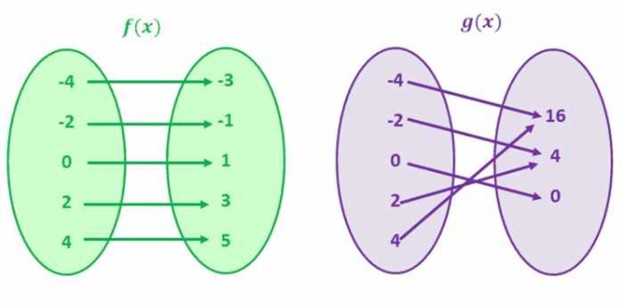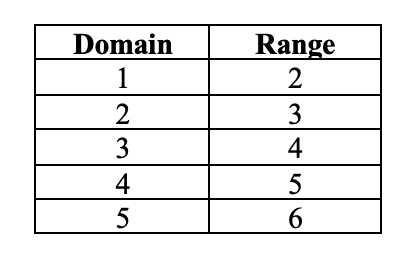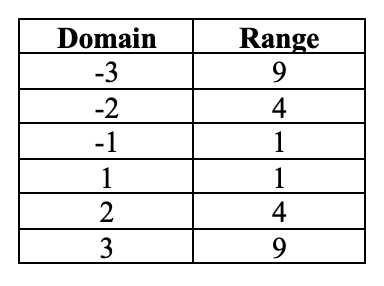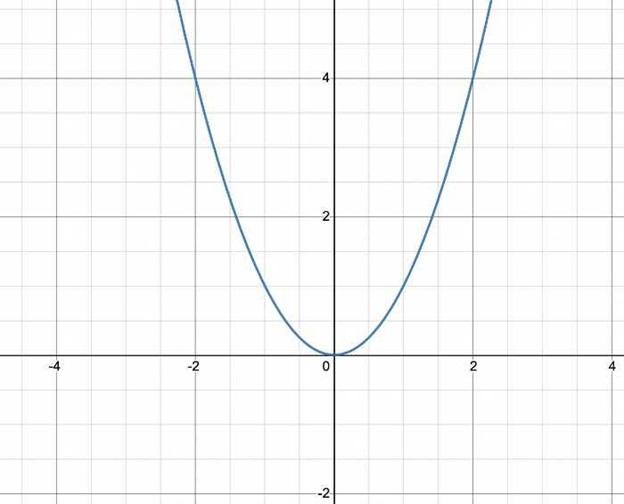One to One Functions - Graph, Examples | Horizontal Line Test
What is a One to One Function?
A one-to-one function is a mathematical function whereby each input corresponds to a single output. In other words, for every x, there is just one y and vice versa. This signifies that the graph of a one-to-one function will never intersect.
The input value in a one-to-one function is the domain of the function, and the output value is noted as the range of the function.
Let's look at the images below:

For f(x), every value in the left circle correlates to a unique value in the right circle. In the same manner, any value on the right side corresponds to a unique value on the left. In mathematical terms, this implies every domain owns a unique range, and every range owns a unique domain. Thus, this is a representation of a one-to-one function.
Here are some different examples of one-to-one functions:
-
f(x) = x + 1
-
f(x) = 2x
Now let's look at the second picture, which shows the values for g(x).
Be aware of the fact that the inputs in the left circle (domain) do not own unique outputs in the right circle (range). For example, the inputs -2 and 2 have the same output, that is, 4. Similarly, the inputs -4 and 4 have the same output, i.e., 16. We can comprehend that there are equivalent Y values for many X values. Hence, this is not a one-to-one function.
Here are some other examples of non one-to-one functions:
-
f(x) = x^2
-
f(x)=(x+2)^2
What are the characteristics of One to One Functions?
One-to-one functions have these properties:
-
The function has an inverse.
-
The graph of the function is a line that does not intersect itself.
-
The function passes the horizontal line test.
-
The graph of a function and its inverse are the same with respect to the line y = x.
How to Graph a One to One Function
When trying to graph a one-to-one function, you will need to determine the domain and range for the function. Let's look at a straight-forward representation of a function f(x) = x + 1.

Once you possess the domain and the range for the function, you ought to graph the domain values on the X-axis and range values on the Y-axis.
How can you tell whether a Function is One to One?
To prove whether or not a function is one-to-one, we can use the horizontal line test. As soon as you plot the graph of a function, trace horizontal lines over the graph. If a horizontal line passes through the graph of the function at more than one place, then the function is not one-to-one.
Because the graph of every linear function is a straight line, and a horizontal line will not intersect the graph at more than one place, we can also deduct all linear functions are one-to-one functions. Don’t forget that we do not leverage the vertical line test for one-to-one functions.
Let's examine the graph for f(x) = x + 1. Immediately after you chart the values to x-coordinates and y-coordinates, you ought to examine if a horizontal line intersects the graph at more than one place. In this instance, the graph does not intersect any horizontal line more than once. This indicates that the function is a one-to-one function.

On the contrary, if the function is not a one-to-one function, it will intersect the same horizontal line more than one time. Let's examine the diagram for the f(y) = y^2. Here are the domain and the range values for the function:

Here is the graph for the function:

In this instance, the graph intersects numerous horizontal lines. For instance, for each domains -1 and 1, the range is 1. In the same manner, for either -2 and 2, the range is 4. This implies that f(x) = x^2 is not a one-to-one function.
What is the inverse of a One-to-One Function?
Considering the fact that a one-to-one function has only one input value for each output value, the inverse of a one-to-one function also happens to be a one-to-one function. The opposite of the function basically undoes the function.
Case in point, in the example of f(x) = x + 1, we add 1 to each value of x in order to get the output, or y. The opposite of this function will deduct 1 from each value of y.
The inverse of the function is f−1.
What are the qualities of the inverse of a One to One Function?
The qualities of an inverse one-to-one function are no different than every other one-to-one functions. This means that the inverse of a one-to-one function will hold one domain for every range and pass the horizontal line test.
How do you find the inverse of a One-to-One Function?
Determining the inverse of a function is simple. You just need to swap the x and y values. For instance, the inverse of the function f(x) = x + 5 is f-1(x) = x - 5.

Just like we discussed earlier, the inverse of a one-to-one function undoes the function. Since the original output value required us to add 5 to each input value, the new output value will require us to subtract 5 from each input value.
One to One Function Practice Questions
Consider these functions:
-
f(x) = x + 1
-
f(x) = 2x
-
f(x) = x2
-
f(x) = 3x - 2
-
f(x) = |x|
-
g(x) = 2x + 1
-
h(x) = x/2 - 1
-
j(x) = √x
-
k(x) = (x + 2)/(x - 2)
-
l(x) = 3√x
-
m(x) = 5 - x
For each of these functions:
1. Determine whether or not the function is one-to-one.
2. Plot the function and its inverse.
3. Figure out the inverse of the function algebraically.
4. Specify the domain and range of both the function and its inverse.
5. Employ the inverse to find the solution for x in each formula.
Grade Potential Can Help You Master You Functions
If you find yourself struggling trying to understand one-to-one functions or similar topics, Grade Potential can set you up with a 1:1 instructor who can assist you. Our Bronx math tutors are experienced professionals who assist students just like you enhance their mastery of these concepts.
With Grade Potential, you can learn at your individual pace from the convenience of your own home. Schedule a call with Grade Potential today by calling (718) 395-5954 to find out more about our teaching services. One of our consultants will contact you to better determine your requirements to set you up with the best teacher for you!




